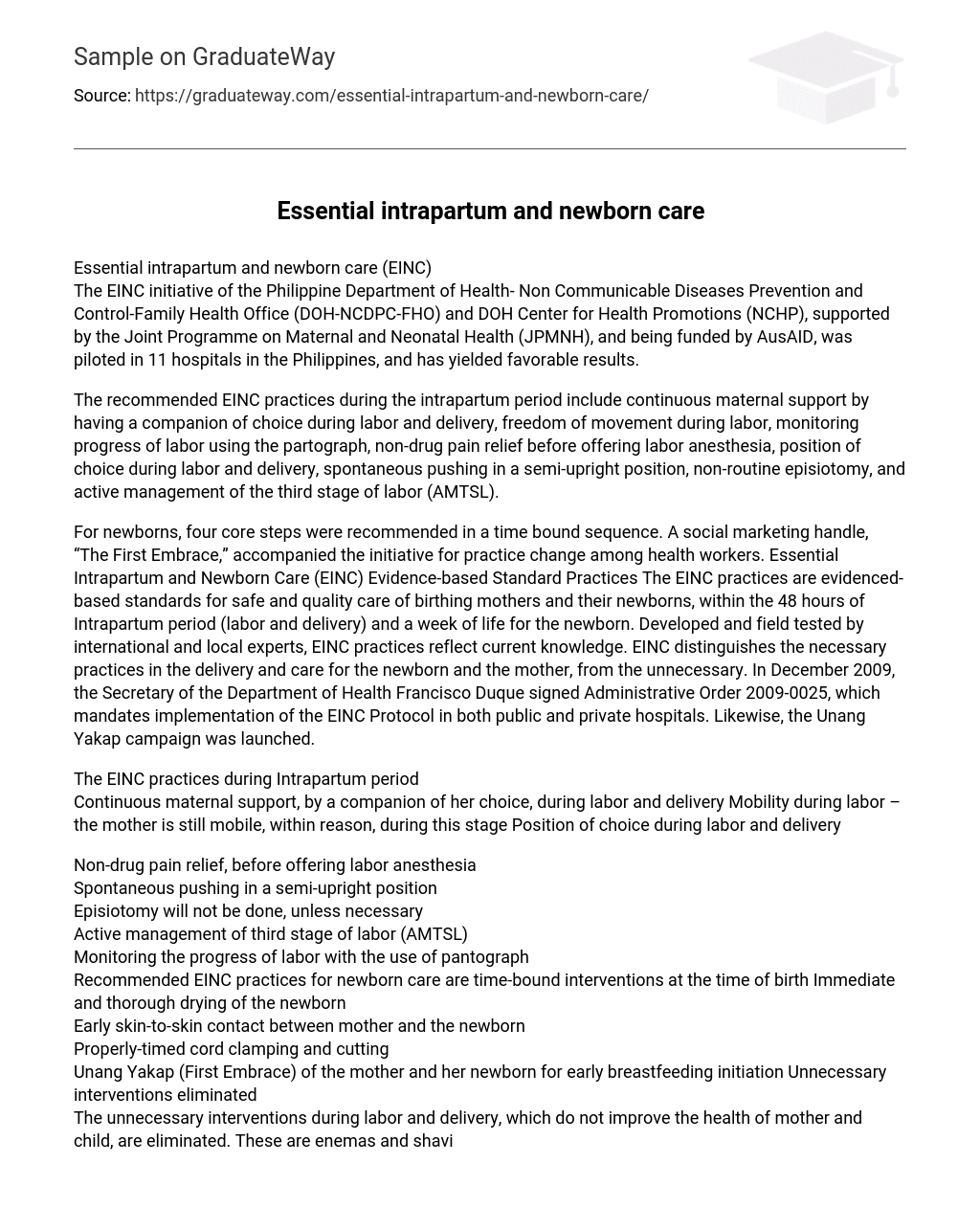The EINC initiative of the Philippine Department of Health- Non Communicable Diseases Prevention and Control-Family Health Office (DOH-NCDPC-FHO) and DOH Center for Health Promotions (NCHP), supported by the Joint Programme on Maternal and Neonatal Health (JPMNH), and being funded by AusAID, was piloted in 11 hospitals in the Philippines, and has yielded favorable results.
The recommended EINC practices during the intrapartum period include continuous maternal support by having a companion of choice during labor and delivery, freedom of movement during labor, monitoring progress of labor using the partograph, non-drug pain relief before offering labor anesthesia, position of choice during labor and delivery, spontaneous pushing in a semi-upright position, non-routine episiotomy, and active management of the third stage of labor (AMTSL).
For newborns, four core steps were recommended in a time bound sequence. A social marketing handle, “The First Embrace,” accompanied the initiative for practice change among health workers. Essential Intrapartum and Newborn Care (EINC) Evidence-based Standard Practices The EINC practices are evidenced-based standards for safe and quality care of birthing mothers and their newborns, within the 48 hours of Intrapartum period (labor and delivery) and a week of life for the newborn.
Developed and field tested by international and local experts, EINC practices reflect current knowledge. EINC distinguishes the necessary practices in the delivery and care for the newborn and the mother, from the unnecessary. In December 2009, the Secretary of the Department of Health Francisco Duque signed Administrative Order 2009-0025, which mandates implementation of the EINC Protocol in both public and private hospitals. Likewise, the Unang Yakap campaign was launched.
The EINC practices during Intrapartum period
- Continuous maternal support, by a companion of her choice, during labor and delivery
- Mobility during labor – the mother is still mobile, within reason, during this stage Position of choice during labor and delivery
- Non-drug pain relief, before offering labor anesthesia
- Spontaneous pushing in a semi-upright position
- Episiotomy will not be done, unless necessary
- Active management of third stage of labor (AMTSL)
- Monitoring the progress of labor with the use of pantograph
- Recommended EINC practices for newborn care are time-bound interventions at the time of birth Immediate and thorough drying of the newborn
- Early skin-to-skin contact between mother and the newborn
- Properly-timed cord clamping and cutting
- Unang Yakap (First Embrace) of the mother and her newborn for early breastfeeding initiation
- Unnecessary interventions eliminated
The unnecessary interventions during labor and delivery, which do not improve the health of mother and child, are eliminated. These are enemas and shavings, fluid and food intake restriction, and routine insertion of intravenous fluids. Fundal pressure to facilitate second stage of labor is no longer practiced, because it resulted to maternal and newborn injuries and death.
Likewise, the unnecessary interventions in newborn care which include routine suctioning, early bathing, routine separation from the mother, foot printing, application of various substances to the cord, and giving pre-lacteals or artificial infant milk formula or other breast-milk substitutes.
Government and international Support
Since 2010, WHO supports the DOH in changing practices for safe and quality care of mothers and newborns for all practitioners and health facilities. It was initially implemented in 11 selected government hospitals collectively representing about 70,000 annual live births (around 3% of all national live births). AusAID also provided support through the Joint Programme on Maternal and Neonatal Health (JPMNH).





